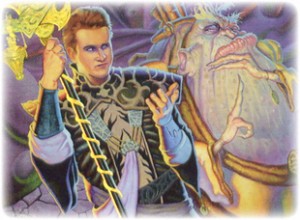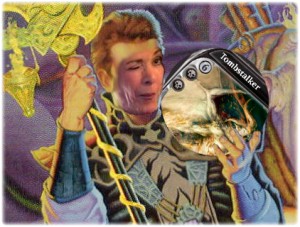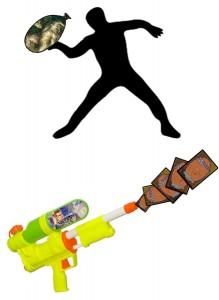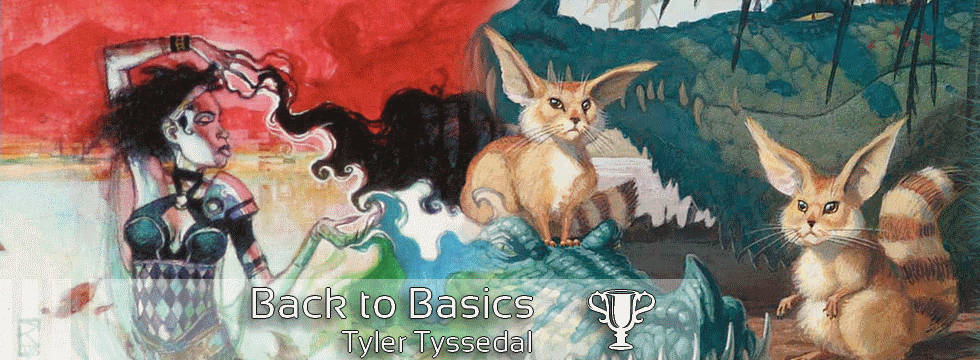Are you a Quiet Speculation member?
If not, now is a perfect time to join up! Our powerful tools, breaking-news analysis, and exclusive Discord channel will make sure you stay up to date and ahead of the curve.
The classic BUG tempo deck has seen success in various configurations. We’ll discuss the choice between Tombstalker and Dark Confidant and the new inclusion of Mental Misstep.
For those unfamiliar with Team America, take a quick gander at what this archetype has to offer:
You’d be hard pressed to find a stronger roster of powerful cards. As it’s nice to see what a deck could look like, I’ll just leave my current build here for reference.
Team America, by Tyler Tyssedal
A Quick Look at “the” Legacy Meta
Team America has traditionally won by establishing tempo by [Card Stifle]stifling[/Card] an opponent’s fetch, [card Hymn to Tourach]Hymning[/card] two cards from their hand, and landing a [card Tombstalker]big[/card] [card Tarmogoyf]old[/card] [card Terravore]fatty[/card] with [card Kira, Great Glass Spinner]counter[/card] [card Force of Will]backup[/card] [card Spell Pierce]in[/card] [card Daze]hand[/card]. [card Brainstorm]Efficiency[/card] and [card Jace, the Mind Sculptor]card advantage[/card] at its finest.
This may be obvious to some, but metagames shift and what worked a few weeks ago may no longer be positioned as well as it was. Some may remember when Team America ran Sinkhole over Hymn to Tourach, narrowing in on land destruction. Then came Zoo and its uncannily efficient creatures. Suddenly that turn two Sinkhole didn’t seem so appealing with an already swelling board presence staring you down—especially on the draw.
Every deck goes through these changes. The 75 should never be considered concrete in a format like Legacy where the success of one deck sends a ripple across all playmats. If combo does well one week, decks that can beat combo come out of hiding in order to take advantage an easy matchup.
And then decks that can beat the deck that can beat combo come out of hiding in attempt to take advantage of an easy matchup.
But there are no perfect matchups. You can’t simply pick next week’s “best deck” and win. You’re not likely to face your best matchup every round and it’s possible that some may be looking ahead and predicting which decks will have a resurgence and opting to go with that archetype.
So the deck you play this week that would have had a good chance in last week’s meta is now playing against one of its worst matchups.
Seems like there’s a lot to think about when deciding which cards to play.
Suffice to say, you can’t always beat the meta. So first start by playing what you like—trusting that many others will be doing the same thing. Since Team America has a fair matchup against most decks and fits my play style, I usually find myself gravitating towards BUG when not otherwise compelled.
So. Back to Team America. Well? What’s good?
One of the biggest decisions the dedicated Team America player has to make right now is which creatures to run. Tarmogoyf is the sole reason we run green—everything else that is green in the deck is a result of Tarmogoyf coming to the party. He’s big and starts the clock.
With cantrips and tempo aplenty, Team America feels most comfortable running 8-10 creatures. With Goyf on board, we have 4-6 slots left to fill.
The traditional choice is a complimentary four-of Tombstalker. A 5/5 flyer for BB? He’s a beast, there’s no doubt about it, and he alone sets a four turn clock. Our graveyard fills quickly with our fetches, cantrips, and spells, so it’s not uncommon to land the demon on turn three or four.
But wait! Do you hear that?

Of course! Play [card Dark Confidant]Bob[/card], too!
Tombstalker vs. Dark Confidant
So Dark Confidant is an option. A very lucrative option. He provides a free card every turn for just a little bit of life. If you couple him with Jace, the Mind Sculptor, you can set up your Bob triggers with Jace’s Brainstorming and essentially draw three cards for free every turn.
And who wouldn’t want that?

Tombstalker's converted mana cost is 8. We already have four Force of Wills that manage their way to the top of the deck once in a while. So, while it would be nice to have both a 5/5 flyer and a 2/1 that draws us a card every turn, we have to decide between one or the other.
However, an issue arises when we consider giving up Tombstalker in favor of Dark Confidant:
It dramatically changes how the deck plays.
Tombstalker provides a clock. If you can protect his body, he will usually win you the game, flying through the air with a resolved slam dunk. You spend the match leading up to his casting gaining card advantage through your opponent’s loss of tempo generated by disrupting and preventing their plan while furthering yours—filling your graveyard for his food. His casting is always a pivotal moment in the match.
Tombstalker applies pressure and forces your opponent to find an answer. His evasion flies over creatures on the ground and your counter spells can protect him or deny your opponent’s must-answer spell. Suddenly the spotlight is aimed on the demon in the room. That’s right where we want it.
[card Dark Confidant]Bob[/card], on the other hand, dances to a different tune. Where a turn two Hymn to Tourach is what we hope for, a turn two Bob is as equally impressive. Especially if he draws you into that Hymn. But, at that point, the way we approach winning is altered. If your opponent has a creature on the field, you won’t want to throw [card Dark Confidant]Bob[/card]’s little body at it. While Tombstalker simply glides over, [card Dark Confidant]Bob[/card] doesn’t attack unless he will survive—or you secretly want him dead.
Dark Confidant is a different type of pressure.
The way the deck fundamentally operates changes when we switch out Tombstalker for Dark Confidant. Instead of the tempo disruption and big flying beats, with [card Tarmogoyf]Goyf[/card] running backup on the ground, we have to shift into another mode of winning, one that takes advantage of Dark Confidant’s card advantage. More trust that the [card Tarmogoyf]Lhurgoyf[/card]([card Terravore]s[/card]) on the floor will get through and deliver the beats.
Team America with Dark Confidant?
I’m going to make a bold statement here, so please let me know why you may disagree:
The deck is no longer Team America if it doesn’t run Tombstalker.
Any Team America build with Dark Confidant is known as Team America by name and color association alone. For example, take Gerry Thompson’s well earned 3rd place finish with a Bob’d Team America:
Team America, by Gerry Thompson
Untitled Deck
Hymn, Inquisition, Thoughtseize, Wasteland, and the counters are all solid sources of disruption. You can strip a card from their hand, make them discard two others, and then safely land a creature that will either beat or draw you cards.
No Stifles to emphasize the tempo gain through land destruction. No reason to fill your graveyard with haste. Less focus is placed on taking advantage of your unanswered threats’ ability to end the game with more focus placed on drawing further counters and disruption in order to maintain the tempo. You can’t rely on a flyer to swing over an opposing army, so instead you need to establish a position where you can clear their threats out of the way—or strip them from their hand—so that your creatures can get through.
Plus, there’s always Jace, the Mind Sculptor. While I include him in my Tombstalker builds because he’s that good, he really shines when Bob is courting him. Jace’s Brainstorm can supply Bob with an unlimited supply of free draws, netting a total of three cards per turn.
Three cards per turn.
Not only that, you can fateseal/scry and ultimate as another win condition if the board is a stalemate. Plus you can unsummon their blockers and force them to discard or counter on the recast, all while clearing the board to get damage in.
The synergy and interactions available are certainly beautiful. But, again, the deck shifts focus with the mere swapping of a single creature.
If Tombstalker were a water balloon, Dark Confidant would be a super soaker.

And Team America is a water balloon. It’s been the fundamental nature of the deck to fill the graveyard like a faucet stretching a balloon, landing with an explosion when the time is right. Sure, sometimes the balloon misses the target (i.e. A lost counter war) or your opponent catches it and throws it back (Vedalken Shackles, Sower Of Temptation, Jace’s unsummon), but when it hits, it drenches.
But by no means is BUG disruption a bad route to take. Bob delivers longevity and an increasing stream of pressure. I agree with the majority who consider him one of the best two drops ever.
I’ve played Team America builds with Tombstalker, Dark Confidant, and even Counterbalance and Sensei's Divining Top. I don’t want to hearken too long on the semantics of naming a deck, but calling any BUG build Team America is like calling any Bant build New Horizons. Sure, both decks share a lot of the same cards, but you use those cards with a different route in mind.
So? Tombstalker or Dark Confidant?
I can’t tell you which one is better, but I want to be clear that the decision is not merely the choice of one card slot. Whichever you choose affects how the deck operates, so it would be wise to reconsider other cards in the deck as well. Typically, Stifle seems to be the first to go when you make the transition. Games seem to go a bit longer and the tempo gained by picking off the beginning fetch does not carry as much weight as before.
Plus, some people simply hate playing Stifle, for whatever reason. Personally, I like the card and I have no problem with pitching it to a [card Force of Will]Force[/card] or [card Brainstorm]shuffling it away[/card] late game, but it does seem to lose its place when it's paired with [card Dark Confidant]Bob[/card] and not the 5/5 delver.
I’ve had success with both at different periods in time. If I had to advise, I would say you should play the one you like the most. If it starts failing you, it’s never too late to switch it up.
Unless, of course, you’ve already turned in your list.
Room for Mental Misstep
One of the worst things about having only 8-10 creatures is getting one removed. We can’t always offer the protection we’d like. It also happens to be that many people are skilled at top decking that removal spell right when they need it.
I’ve been playing a singleton Kira, Great Glass Spinner main as a lead-in shield, with another in the side against removal heavy decks. She’s done her job more than once by forcing an opponent to throw two spells at her—sometimes the second getting countered as well.
In most games, however, we only have one way of hard countering a [card Swords to Plowshares]Swords[/card]/[card Path to Exile]Path[/card]—Force of Will. Force also happens to require an additional blue card to pitch, which can be troublesome when we just spend our last few turns filling our graveyard with cards. Most people naturally play around Daze, seeing that [card Swords to Plowshares]Swords[/card] and Path to Exile are both one cost spells and we sometimes land a creature while they have more than one land.
Mental Misstep protects our creatures. Outside of countering a detrimental turn 1 Goblin Lackey, Aether Vial, Grindstone, Goblin Welder, and the occasional Dark Ritual, the main purpose that Misstep will find itself performing in this deck will be protecting the creatures and furthering the game plan.
Mental Misstep will be performing a relatively vital role, and it’s not just an auto-include because it’s the latest fashion. Daze becomes ineffectual late game and Mental Misstep is a hard anti-removal counter. Four of them actually seems right.
But what to cut…
After some testing, this is what I’ve decided I don’t want to see in the deck:
4 Force of Will
3 Daze
4 Stifle
4 Mental Misstep
That is far too many spells that do little to actually win the game. We want at least four removal spells (some combination of Maelstrom Pulse, Smother, and Go for the Throats, optimally) and enough threats to last. I prefer running 10 creatures and 2 Jaces, so those, for me, are off limits. If we’re going to be committed to running Hymn to Tourach, we run four. Force of Will isn’t an option, either.
4 Brainstorms and 3 Ponders keep the deck consistent. I can see going down to 2 Ponders, especially if we run Dark Confidant over Tombstalker, but that’s really the only place I can see trimming.
So our options are:
-3 Daze
-1 Ponder
+4 Mental Misstep
Or
-4 Stifle
+4 Mental Misstep
At first glance it would seem that cutting Daze is the logical choice, as both Daze and Misstep are counter spells. But Daze and Misstep usually do completely different things. Daze can stop a one drop on the play, but it typically exists to punish an overly aggressive opponent who taps out to play a threat. Its synergy with Stifle and Wasteland shouldn’t be overlooked.
Stifle, though, is actually closer to Misstep in terms of conditionality with what it can actually do. It punishes fetch lands, Wastelands, and other activated or triggered abilities, but it’s a reactive tempo card that can be the unexpected invisible wire that causes someone to trip. Though its restrictions are closer to that of Misstep’s than Daze is, it doesn’t do the same thing.
So what combination offers the best synergy?
- Daze and Stifle compliment one another, having obvious synergy.
- Daze and Mental Misstep counter different types of cards, rarely becoming redundant.
- Stifle and Mental Misstep have no direct synergy. Although it’s punishing to Stone Rain an opponent’s land for U, the effectiveness of Mental Misstep remains the same.
Not to mention how Stifle is a valid target for Mental Misstep while Daze isn’t.
If you want to play Mental Misstep, I would advise cutting Stifle. If you’re not playing Stifle, then I would also recommend playing Dark Confidant instead of Tombstalker. Thoughtseize and Inquisition of Kozilek are also aggressive discard outlets that may prove to be better than Daze, so toy around with cutting 3 Dazes, and possible a single Ponder, for some combination of 3 Thoughtseize and Inquisition, as the discard is a more consistent way to prevent a card from entering the field. Daze does aid in counter wars, though, so it’s an idea still needing further exploration.
However, if you want to rock Stifle, I would say stick with Tombstalker and cut 3 Daze (and perhaps 1 Ponder) for 3-4 Mental Missteps. You lose your ability to Daze some of your opponent’s spells, but you’re investing in protecting your black flyer. Swords, Path, and Go for the Throats are some of the most common ways to kill an 8 drop 5/5 black flyer, and Daze is pretty useless against those cards as it is.
It is also wise to note that we may see a drop in one-drop removal with the fear of Misstep being everywhere, so pay attention to that.
Some Preliminary +Mental Misstep Decklists
As other decks shape up in preparation for GP Providence, we’ll have a better idea of what the field could look like. More testing is underway, but I’ll leave you here with a few BUG Misstep Tempo builds to consider.
BUG Tempo, by Tyler Tyssedal
Untitled Deck
BUG Disruption, by Drew Lavin
Untitled Deck
Team America, by Tyler Tyssedal
Untitled Deck
Until next time,
Tyler Tyssedal





